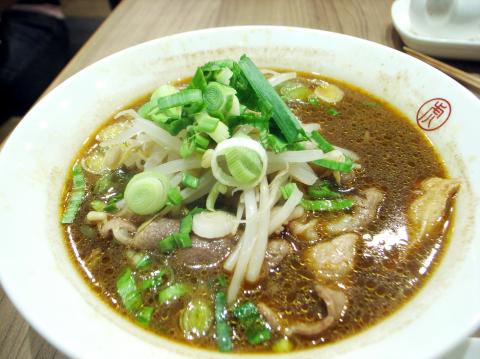As the winter chill looms, Ma Shan Tang (麻膳堂), where spicy noodle soups and dumplings are served up in a shop that looks like a contemporary Japanese bistro, is a lunch locale to keep in mind if you’ll be in Taipei’s East District (東區).
Come dressed warmly — lines of people out the door have been the norm since Ma Shan Tang opened in July. On several recent visits, the place was packed with neighborhood office workers even after 1:30pm.
Also in the restaurant’s favor are reasonable prices, with noodle soups costing between NT$120 and NT$140.

Photo: David Chen, Taipei Times
The shop’s specialty, spicy beef noodle soup (麻辣牛肉麵, NT$140), comes loaded with generous amounts of thin beef slices, long strips of fried tofu and duck blood tofu. The bowls are topped with freshly chopped bean sprouts and green onions. Pork, or lamb, is available instead of beef for the same price.
The broth strikes a nice balance between its spicy bite and a subtle flavor that’s both savory and sweet. The chili and spice-laden concoction lit up the taste buds and gave me a slight buzzing sensation at the top of my head, but the spiciness was tolerable. A bowl without noodles is NT$120 and goes well with pork and egg-fried rice (肉絲炒飯, NT$70), or plain boiled dumplings (原味水餃) or the tasty pan-fried dumplings (鮮肉煎餃), each of which comes in sets of 10 for NT$60.
The beef and rice noodles with clear broth (清燉牛肉細粉, NT$120) were a disappointment despite the deliciously tender beef shank slices. The broth was watery and bland.
Ma Shan Tang’s shopfront capitalizes on the popularity of Din Tai Fung (鼎泰豐), with stacks of steaming bamboo baskets of shrimp dumplings (蝦仁蒸餃, NT$90) on display by the window.
The atmosphere feels upscale for a noodle joint, but it’s still casual enough. The wood floors, gallery lighting and carved chopsticks give off a relaxing, almost Zen-like vibe. And, thankfully, there are no TVs blaring out cable news. Instead, the shop plays music from a refreshing mix of Western artists (Lisa Ono, Frank Sinatra, the Gipsy Kings), which went down well with the spicy noodles.
Ma Shan Tang is located near Exit 2 of Sun Yat-sen Memorial Hall MRT Station (國父紀念館捷運站).
Address: 24, Ln 280, Guangfu S Rd, Taipei City (台北市光復南路280巷24號)

June 2 to June 8 Taiwan’s woodcutters believe that if they see even one speck of red in their cooked rice, no matter how small, an accident is going to happen. Peng Chin-tian (彭錦田) swears that this has proven to be true at every stop during his decades-long career in the logging industry. Along with mining, timber harvesting was once considered the most dangerous profession in Taiwan. Not only were mishaps common during all stages of processing, it was difficult to transport the injured to get medical treatment. Many died during the arduous journey. Peng recounts some of his accidents in

“Why does Taiwan identity decline?”a group of researchers lead by University of Nevada political scientist Austin Wang (王宏恩) asked in a recent paper. After all, it is not difficult to explain the rise in Taiwanese identity after the early 1990s. But no model predicted its decline during the 2016-2018 period, they say. After testing various alternative explanations, Wang et al argue that the fall-off in Taiwanese identity during that period is related to voter hedging based on the performance of the Democratic Progressive Party (DPP). Since the DPP is perceived as the guardian of Taiwan identity, when it performs well,

A short walk beneath the dense Amazon canopy, the forest abruptly opens up. Fallen logs are rotting, the trees grow sparser and the temperature rises in places sunlight hits the ground. This is what 24 years of severe drought looks like in the world’s largest rainforest. But this patch of degraded forest, about the size of a soccer field, is a scientific experiment. Launched in 2000 by Brazilian and British scientists, Esecaflor — short for “Forest Drought Study Project” in Portuguese — set out to simulate a future in which the changing climate could deplete the Amazon of rainfall. It is

Artifacts found at archeological sites in France and Spain along the Bay of Biscay shoreline show that humans have been crafting tools from whale bones since more than 20,000 years ago, illustrating anew the resourcefulness of prehistoric people. The tools, primarily hunting implements such as projectile points, were fashioned from the bones of at least five species of large whales, the researchers said. Bones from sperm whales were the most abundant, followed by fin whales, gray whales, right or bowhead whales — two species indistinguishable with the analytical method used in the study — and blue whales. With seafaring capabilities by humans